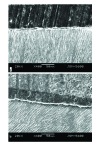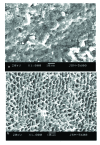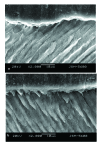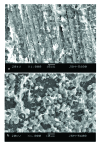Adhesion of two bonding systems to air-abraded or bur-abraded human enamel surfaces
- PMID: 19212543
- PMCID: PMC2635899
Adhesion of two bonding systems to air-abraded or bur-abraded human enamel surfaces
Abstract
Objectives: The purpose of this in vitro study was to evaluate whether mechanical alteration of the enamel surfaces with air abrasion and bur abrasion techniques could enhance the bonding performance of a three step and a self etching adhesive resin systems to enamel.
Methods: 126 extracted lower human incisor teeth were used. The teeth were divided into three groups including 40 teeth each. First group; teeth were used as control and no preparation was made on enamel surfaces, 2(nd) group; outer enamel surfaces were air abraded, 3(rd) group; outer enamel surfaces were abraded mechanically with a diamond fissure bur. Cylinder composite resin blocks were bonded to the buccal enamel surfaces with two bonding systems (20 specimens in each group). Bond strengths to enamel surfaces were measured at a cross-head speed of 1 mm/min. The data were analyzed by ANOVA and Duncan Tests. To examine interface composite resin/enamel surfaces at scanning electron microscopy, remaining 6 teeth were used. Fracture analysis was performed using an optical stereomicroscope.
Results: Bond strengths values of Solid Bond were significantly higher than bond strengths of Clearfil SE Bond for all types of enamel (P<.05). Shear bond strength values obtained with Solid Bond (three step system) to three types of enamel surfaces [air-abraded (30.25+/-7.00 MPa), bur-abraded (29.07+/-3.53 MPa), control (31.74+/-7.35 MPa)] were close to each other (P>.05). The macroscopic mode of failures for bonding systems, SB and SE Bond appeared to be adhesive and cohesive in nature.
Conclusions: In order to get better bond strength values with self etching systems, it is advisable to prepare enamel surfaces with bur or air abrasion, but it enamel preparation is not necessary for three step systems.
Keywords: Adhesion; Air-abrasion; Bur-abrasion; Enamel surfaces; Self etching.
Figures






Similar articles
-
An in vitro investigation of a comparison of bond strengths of composite to etched and air-abraded human enamel surfaces.J Prosthodont. 2006 Jan-Feb;15(1):2-8. doi: 10.1111/j.1532-849X.2006.00062.x. J Prosthodont. 2006. PMID: 16433645
-
Effect of dentinal surface preparation on bond strength of self-etching adhesives.J Adhes Dent. 2008 Jun;10(3):173-82. J Adhes Dent. 2008. PMID: 18652265 Clinical Trial.
-
Microshear bond strength of self-etching bonding systems to ultrasound diamond bur-prepared dentin.J Adhes Dent. 2011 Oct;13(5):433-8. doi: 10.3290/j.jad.a19650. J Adhes Dent. 2011. PMID: 20978642 Clinical Trial.
-
Effect of different adhesion strategies on bond strength of resin composite to composite-dentin complex.Oper Dent. 2013 Jan-Feb;38(1):63-72. doi: 10.2341/11-482-L. Epub 2012 Jul 19. Oper Dent. 2013. PMID: 22812912 Clinical Trial.
-
Bonding Surface Designs in Fixed Orthodontic Attachments.Int J Dent. 2023 Jan 23;2023:2846879. doi: 10.1155/2023/2846879. eCollection 2023. Int J Dent. 2023. PMID: 36726859 Free PMC article. Review.
Cited by
-
Bond strength of one-step self-etch adhesives and their predecessors to ground versus unground enamel.Eur J Dent. 2012 Jul;6(3):280-6. Eur J Dent. 2012. PMID: 22904656 Free PMC article.
-
Dentin pretreatment and adhesive temperature as affecting factors on bond strength of a universal adhesive system.J Appl Oral Sci. 2017 Sep-Oct;25(5):533-540. doi: 10.1590/1678-7757-2016-0500. J Appl Oral Sci. 2017. PMID: 29069151 Free PMC article.
-
Cuspal movement related to different bonding techniques using etch-and-rinse and self-etch adhesive systems.Eur J Dent. 2009 Jul;3(3):213-8. Eur J Dent. 2009. PMID: 19756196 Free PMC article.
-
Effect of Bioactive Glass air Abrasion on Shear Bond Strength of Two Adhesive Resins to Decalcified Enamel.J Dent (Tehran). 2014 Nov;11(6):644-54. Epub 2014 Nov 30. J Dent (Tehran). 2014. PMID: 25628694 Free PMC article.
References
-
- Nikaido T, Kataumi M, Burrow MF, Inokoshi S, Yamada T, Takatsu T. Bond strengths of resin to enamel and dentin treated with low-pressure air abrasion. Oper Dent. 1996;21:218–224. - PubMed
-
- Olsen ME, Bishara SE, Damon P, Jakobsen JR. Comparison of shear bond strength and surface structure between conventional acid etching and air-abrasion of human enamel. Am J Orthod Dentofac Orthop. 1997;112:502–506. - PubMed
-
- Zyskind D, Zyskind K, Hirschfeld Z, Fuks AB. Effect of etching on leakage of sealants placed after air abrasion. Pediatr Dent. 1998;20:25–27. - PubMed
-
- Kanellis MJ, Warren JJ, Levy SM. Comparison of air abrasion versus acid etch sealant techniques: six-month retention. Pediatr Dent. 1997;19:258–261. - PubMed
-
- Jahn KR, Geitel B, Kostka E, Wischnewski R, Roulet JF. Tensile bond strength of composite to air-abraded enamel. J Adhes Dent. 1999;1:25–30. - PubMed
LinkOut - more resources
Full Text Sources
Miscellaneous
